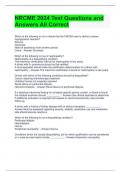Exam (elaborations)
NRCME 2024 Test Questions and Answers All Correct
- Course
- Institution
NRCME 2024 Test Questions and Answers All Correct Which of the following is not a criteria that the FMCSA uses to define a severe hypoglycemic reaction? Seizure. Dizziness. Need of assistance from another person. Coma. - Answer-Dizziness. Which of the following is true of nephropathy? N...
[Show more]



